What’s Cook’n? How About Pannekoeken?
Do you have a favorite breakfast dish you enjoy serving at holiday gatherings? With the 4th of July coming up, I thought I’d share an idea for a family breakfast that I found on one of my favorite websites, The Prepared Pantry (www.preparedpantry.com).
Dennis Weaver, owner of Prepared Pantry, recommends pannekoeken because, like German pancakes, they are easy to whip up and truly scrumptious. Basically, pannekoeken, a Dutch favorite, is kind of like an omelet, but with a pancake foundation. It’s much like a German pancake, but with some fun and interesting differences:
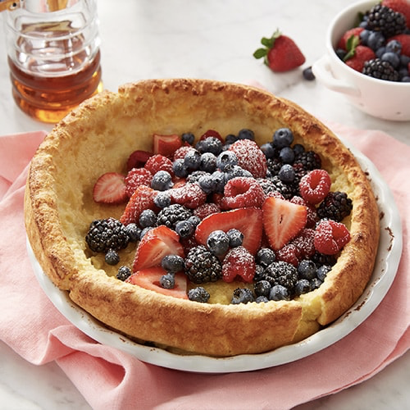
Pannekoeken is steam driven and as the batter expands, it slides across the smooth surface of the pan, rounds the gentle curves, and slides up the sides of the pan. When the pannekoeken comes from the oven, you have a dramatic bowl extending three or four inches above the sides of the pan. It’s appearance is part of its charm—it makes a stunning presentation.
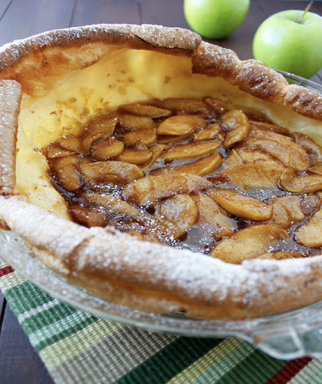
While it’s nice to have a dedicated pan for the job, the good news is, your cast iron skillet will work just fine as well! If your skillet has a gently rounded transition from bottom to sides and a good nonstick surface, you can use that. An 11-inch round nonstick skillet works well for a three-egg pannekoeken. And an 8-inch round nonstick skillet or 9 1/2-inch round nonstick skillet works well for a two-egg pannekoeken.
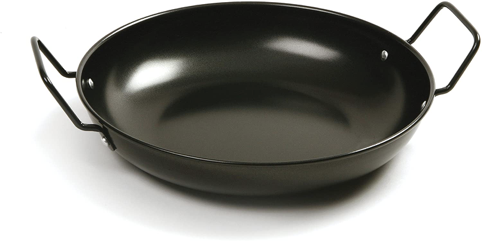
Now here’s the Prepared Pantry’s 5-Star recipe for the best family breakfast you could want: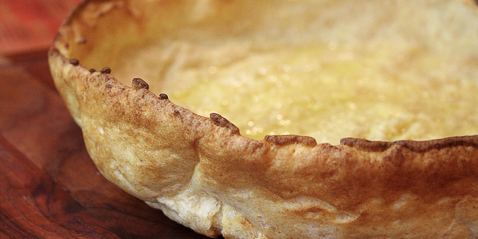

1/4 cup butter
3 large eggs
1/8 teaspoon salt
3/4 cup milk
3/4 cup flour
Directions:
Add Recipe to Cook'n
blog comments powered by Disqus
Dennis Weaver, owner of Prepared Pantry, recommends pannekoeken because, like German pancakes, they are easy to whip up and truly scrumptious. Basically, pannekoeken, a Dutch favorite, is kind of like an omelet, but with a pancake foundation. It’s much like a German pancake, but with some fun and interesting differences:

- The pannekoeken forms a big, tall bowl while German pancakes roll and buckle.
- With a pannekoeken, the fruit goes into the formed bowl after it’s baked. With a German pancake, the fruit goes in before it’s baked.
- A pannekoeken is more versatile. Besides the proverbial fresh fruit and whipped cream approach, you can successfully load it with a savory filling or with meat and potatoes. (It’s difficult to find a single German pancake recipe that does not include fruit, by the way.) A few savory filling suggestions? Try pesto and fresh mozzarella, leftover curry or other stewy sauce, mushrooms and peppers with smoked gouda, artichoke and pequillo peppers, or chili with shredded cheese.
- A pannekoeken is baked in a specialty pan, a pannekoeken pan (commonly known as a Dutch Baby Pan), which has a nonstick surface and sides that round up. A German pancake is often baked in a rectangular pan.
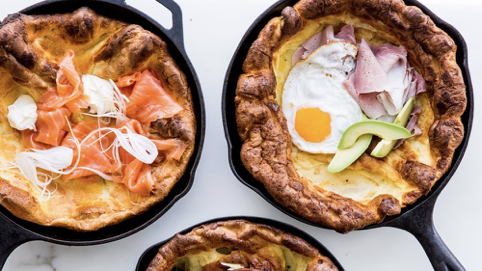
Pannekoeken is steam driven and as the batter expands, it slides across the smooth surface of the pan, rounds the gentle curves, and slides up the sides of the pan. When the pannekoeken comes from the oven, you have a dramatic bowl extending three or four inches above the sides of the pan. It’s appearance is part of its charm—it makes a stunning presentation.

While it’s nice to have a dedicated pan for the job, the good news is, your cast iron skillet will work just fine as well! If your skillet has a gently rounded transition from bottom to sides and a good nonstick surface, you can use that. An 11-inch round nonstick skillet works well for a three-egg pannekoeken. And an 8-inch round nonstick skillet or 9 1/2-inch round nonstick skillet works well for a two-egg pannekoeken.

Now here’s the Prepared Pantry’s 5-Star recipe for the best family breakfast you could want:

Dutch Pannekoeken
Ingredients:
1/4 cup butter
3 large eggs
1/8 teaspoon salt
3/4 cup milk
3/4 cup flour
Directions:
Place the butter in a pannekoeken pan or an ovenproof skillet with rounded sides. Preheat your oven to 425 degrees. Put the rack in the center, not the top, shelf. When you turn the oven on, place the pan with the butter in the oven. When the oven reaches 250 degrees the butter should be melted. Remove the pan from the oven. Whisk the eggs and the salt in a medium bowl. Add the milk. Whisk in the flour until nearly smooth. Your batter is now ready. Pour the batter into the pan.
Bake for 15 to 18 minutes or until the top starts to turn golden brown. Serve hot with your favorite syrup.
Bake for 15 to 18 minutes or until the top starts to turn golden brown. Serve hot with your favorite syrup.
Recipe formatted with the Cook'n Recipe Software from DVO Enterprises.
Sources:
- www.bjs.com
- www.alibaba.com
- www.texascooking.com
- www.foodsafetynews.com
- www.100daysofrealfood.com
- www.kroger.com
- www.bonapetit.com
- www.365kitchen.net
- www.amazon.com
- www.preparedpantry.com
 Alice Osborne
Alice Osborne
Weekly Newsletter Contributor since 2006
Email the author! alice@dvo.com
